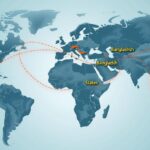Economy
Politics
ANWAR HOSSAIN, ASIA, AWAMI LEAGUE, BANGLADESH, BANGLADESH GARMENT MANUFACTURERS AND EXPORTERS ASSOCIATION, CHINA, CHITTAGONG, CORRUPTION, DENIM EXPERT, DONALD TRUMP, ECONOMY, INDIA, INTERNATIONAL RELATIONS, MEXICO, MUHAMMAD YUNUS, NORTH AMERICA, OFFICE OF THE U. S. TRADE REPRESENTATIVE, ROSE GARDEN, RUB, TRADE, TRUMP, U. S, UNITED STATES, WHITE HOUSE
Dante Raeburn
Bangladesh Faces Economic Turmoil Following New U.S. Tariffs on Exports
Mohiuddin Rubel of the Bangladesh Garment Manufacturers Association was shocked to learn of President Trump’s announcement of a 37 percent tariff on Bangladeshi exports. The United States, Bangladesh’s third-largest trading partner, imported $8.4 billion worth of goods in 2024. The tariff could devastate the economy’s garment sector, which employs 4 million people. Stakeholders express concerns over job losses and increased costs, highlighting the urgency for negotiations and strategic countermeasures.
Mohiuddin Rubel from the Bangladesh Garment Manufacturers and Exporters Association received alarming news while asleep in Chittagong regarding President Trump’s significant tariffs imposed on Bangladeshi exports. Initially unaware, he grasped the gravity of the situation the next morning when Trump declared a 37 percent tariff, primarily affecting ready-made garments, which constitute about 85 percent of Bangladesh’s exports to the U.S.
The United States ranks as Bangladesh’s third-largest trading partner, with imports valued at $8.4 billion in 2024, while the country exported $2.2 billion to the U.S. This resulted in a $6.2 billion trade surplus, which President Trump perceived as Bangladesh “taking advantage” of the U.S. However, the new tariffs could severely impact Bangladesh, still recovering from previous instability.
Anwar Hossain, the temporary administrator of the BGMEA, expressed that Bangladesh was ill-prepared for such a sudden tariff announcement. Meanwhile, Nobel laureate Muhammad Yunus indicated hope for negotiations to secure a favorable agreement. With orders returning from China as a result of earlier tariffs implemented against them, Bangladesh stands at a critical juncture.
The new tariffs may still elevate pricing, challenging Bangladesh’s competitiveness against its neighbors, India and Pakistan, with tariffs of 26 and 29 percent respectively. In contrast, both Vietnam and Sri Lanka face even higher tariffs. This situation underscores the necessity for Bangladeshi manufacturers to negotiate effectively with U.S. buyers to maintain their competitive edge.
Historical wages in Bangladesh present an advantage; however, ongoing wage protests highlight intrinsic challenges. Additionally, to alleviate the tariff burden, Bangladesh must address the alleged 74 percent tariff it imposes on U.S. imports. Data analysis is crucial to determine the accuracy of the claims regarding duty rates.
Urgency surrounds the logistics of existing orders and the need to account for increased costs induced by tariffs. Rubel, expressing concern, stated that increased costs might lead U.S. buyers to purchase less, jeopardizing business for numerous Bangladeshi garment factories that predominantly focus on the U.S. market.
Fazlul Hoque voiced anxiety that U.S. retailers might shift cost burdens onto suppliers rather than increasing retail prices. With the repercussions of American aid cuts already felt among 4 million garment workers, executive Kalpona Akter raised fears of job losses resulting from this economic strain exacerbated by global conflicts.
Faisal Samad acknowledged the high impact on U.S. buyers and factories reliant on American business, emphasizing the significant cost increase on goods. He suggested that negotiations or adjustments must occur on both sides to address the profound effects of these tariffs on Bangladesh’s textile industry.
Proposed strategies include narrowing the U.S.-Bangladesh trade disparity, such as increasing imports of U.S. cotton to offset tariffs. Rubel noted that even a modest decrease in tariffs would improve competitive standing against neighboring countries. He also highlighted concerns surrounding Bangladesh’s impending graduation from the United Nations’ Least Developed Countries classification, which could lead to further tariff complications from the European Union, causing additional strain on the economy.
In summary, the recent imposition of significant tariffs by the United States on Bangladeshi exports poses substantial challenges for the garment industry in Bangladesh. As key stakeholders express concerns over potential job losses and increased costs, negotiations to avert further economic turmoil appear critical. The interdependencies of trade and global market dynamics necessitate careful strategic planning to mitigate adverse impacts and secure a more stable future for Bangladesh’s economy.
Original Source: sourcingjournal.com








Post Comment